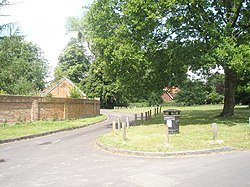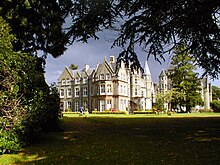Englefield Green
| Englefield Green | |
| Surrey | |
|---|---|
 Englefield Green | |
| Location | |
| Grid reference: | SU995710 |
| Location: | 51°25’48"N, -0°34’12"W |
| Data | |
| Population: | 11,180 |
| Post town: | Egham |
| Postcode: | TW20 |
| Dialling code: | 01784 |
| Local Government | |
| Council: | Runnymede |
| Parliamentary constituency: |
Runnymede and Weybridge |
Englefield Green is a village in northern Surrey, hard by the border with Berkshire. It is home to Royal Holloway, University of London, the south eastern corner of Windsor Great Park and close to the towns of Egham and Virginia Water, and to Windsor in Berkshire. The village was built up in the 19th century and contains some of the most expensive housing in the South East.
Air Forces Memorial

On the road towards Kingswood Hall of Royal Holloway is the Air Forces Memorial which commemorates by name over 20,000 airmen and women who were lost in the Second World War during operations from bases in the United Kingdom and North and Western Europe, and who have no known graves. They served in Bomber, Fighter, Coastal, Transport, Flying Training and Maintenance Commands, and came from all parts of the Commonwealth, as well as some from countries in continental Europe which had been overrun but whose airmen continued to fight in the ranks of the Royal Air Force. The names in their thousands are inscribed on panels in a courtyard.
The memorial sits on a hill overlooking a historic part of the Thames Valley where Magna Carta, enshrining basic freedoms in English law, was signed in 1215. The memorial was designed by Sir Edward Maufe with sculpture by Vernon Hill. The engraved glass and painted ceilings were designed by John Hutton and the poem engraved on the gallery window was written by Paul H Scott. It overlooks the River Thames on Cooper's Hill at Englefield Green between Windsor and Egham on the A328 (Priest Hill), 4 miles from Windsor and is well signposted as 'Air Force Memorial'.
Brunel University Runnymede Campus

Just north of the village is the site which formed the Runnymede campus of Brunel University, formerly Shoreditch College of Education which merged with Brunel and before that the Royal Indian Engineering College. Today the buildings are used as halls of residence for the main campus at Uxbridge, one hour away by bus and also nearby Royal Holloway. The halls were named after Shoreditch staff: Scrivens, Marshall, Bradley, Reed and Rowan. President Hall, where the College president resided, and College Hall were named in the Royal Indian period. The fine Victorian buildings were built by Sir Matthew Digby Wyatt, who had been Isambard Kingdom Brunel's architect for Paddington Station in London, and also Addenbrooke's Hospital, Cambridge, (now the Judge Institute). Corridors in President and College Halls were named after prominent British and Anglo-Indian figures, such as George Canning, Warren Hastings, Richard Wellesley and Charles Cornwallis. In 2007, Brunel sold the site to a property developer, for £46 million.[1]
The last duel

The last fatal duel in England took place on Priest Hill in 1852 between two French refugees, Lt Frederic Constant Cournet and Emmanuel Barthelemy.
Cournet was supposed to have been the better prepared for a sword duel. Barthelemy, a most questionable individual (responsible for at least two murders by 1852), manipulated Cournet into challenging him (supposedly over comments Cournet made about a lady attached to Barthelemy), and chose pistols for the weapon. He killed Cournet, and was subsequently arrested for murder. However Barthelemy managed to convince the jury that it was not a homicide in the normal sense of the word, and was acquitted.
Barthelemy was widely suspected of being a spy for the new French régime of Emperor Napoleon III, though it was his bullying of other refugees which had led to the confrontation with Cournet. Three years later, he was engaged in a crime in London, possibly involving a blackmail attempt that did not succeed. Two men were killed, and Barthelemy was arrested. Despite giving an image of bravado in court, this time he was convicted, and subsequently hanged. Most criminal historians and writers feel he was a totally repugnant character, but to be fair he had one odd defender: Victor Hugo, who wrote a small panagyric to his memory in one of the later sections of Les Miserables.
References
- ↑ Englefield Green Village Residents Association fears development not in keeping with the village
- Englefield Green in Pictures, by Graham Dennis (ISBN 0-9524194-0-8) Fernhurst Books (7 Nov 1994)
- Englefield Green Picture Book, by Graham Dennis (ISBN 0-9508234-6-5) Egham-by-Runnymede Historical Society (Nov 1992)
- Hamill interview